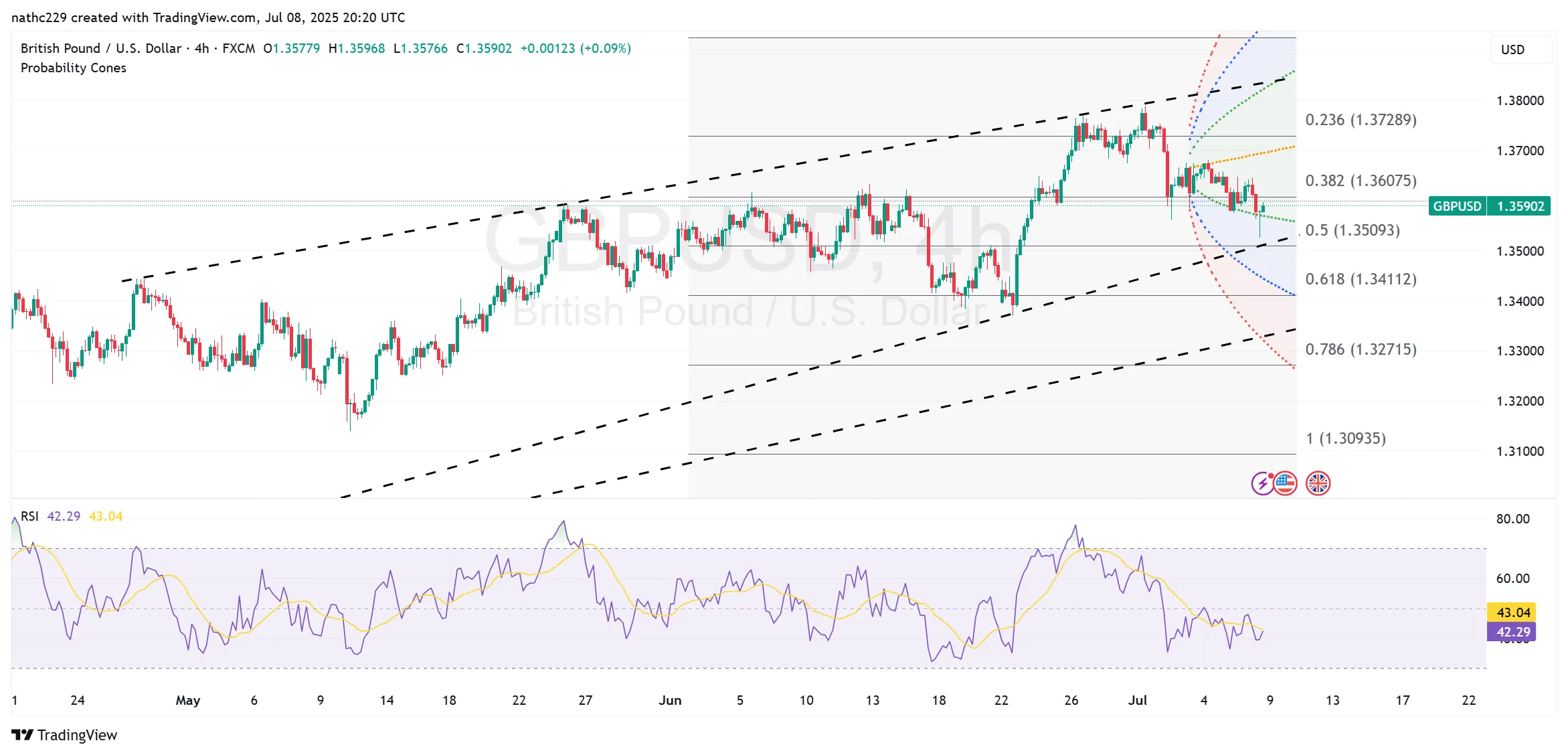
GBP/USD Hits Two-Week Low Amid Rising Gilt Yields and Renewed Fiscal Concerns
GBP/USD Hits Two-Week Low Amid Rising Gilt Yields and Renewed Fiscal Concerns
Overview
GBP/USD has come under substantial pressure, sliding to two-week lows near 1.3540 amid escalating UK fiscal concerns and rising global interest rates triggered by recent U.S. tariff announcements. As the pound’s attractiveness diminishes, investors are increasingly wary of the UK’s fiscal landscape, particularly in the context of growing debt servicing costs driven by higher gilt yields. Traders now closely monitor key technical support levels to gauge the pair’s potential for further downside.
Technical Analysis
GBP/USD began experiencing increased bearish momentum as it decisively broke below its key technical support level at the 10-day moving average (DMA) near 1.3666. The pair now trades around 1.3586, approaching critical short-term supports, with the immediate daily baseline situated at 1.3580, followed closely by Tuesday’s flash low at 1.3528. These levels represent important technical barriers; a clear close below could prompt accelerated declines.
Further downside targets include the 55-DMA at 1.3468 and subsequently the late-June trend low at 1.3373. These support zones are pivotal; breaching them could unleash deeper bearish momentum, targeting even lower psychological and technical thresholds around 1.3250—the 50% Fibonacci retracement of the move from 1.2712 to 1.3787—and eventually towards the critical psychological level at 1.30.
On the upside, immediate resistance is evident at Tuesday’s high of 1.3647, with more substantial resistance at the falling 10-DMA currently located at 1.3671. Further upside barriers reside at the upper boundary of the 30-day Bollinger band near 1.3751 and the recent 2025 high reached on July 1 at 1.3787.
Momentum indicators reinforce the bearish outlook. The declining RSI indicates mounting bearish pressure, and the inability to sustain rebounds above the 10-DMA emphasizes the underlying market weakness.
Fiscal Concerns and Market Sentiment
Sterling’s recent depreciation is significantly influenced by renewed fiscal anxieties, particularly intensified by President Trump’s announcement of 25% tariffs, sparking fears of rising global yields and inflationary pressures. UK gilt yields have notably surged, outpacing yield increases in other developed markets, reflecting investor concerns regarding the UK’s fiscal sustainability amid increasing debt servicing burdens.
The UK’s domestic fiscal environment remains challenging, exacerbated by recent welfare debates highlighting deep-rooted fiscal policy dilemmas. Elevated yields amplify concerns over financing government debt sustainably, thereby diminishing investor confidence in sterling assets.
Additionally, speculative market positioning highlights diminishing investor enthusiasm towards the pound. Net speculative long sterling positions have notably reduced from 51.6k contracts in June to 31.4k contracts currently, indicating bearish sentiment and a declining bullish conviction amongst traders.
Economic Indicators and Risks
Economic indicators further underpin the bearish sentiment surrounding GBP/USD. Elevated U.S. yields, reinforced by robust U.S. economic data and diminishing expectations for immediate Federal Reserve rate cuts, bolster the dollar and intensify downward pressures on GBP/USD.
Conversely, the UK’s economic indicators provide limited support. Inflationary pressures and elevated borrowing costs could strain UK economic growth prospects, further influencing bearish sentiment. Persistent uncertainties surrounding Brexit and broader political stability within the UK add layers of complexity and risk, potentially heightening volatility.
Strategic Considerations
Traders holding bearish positions should closely monitor technical support levels at 1.3580 and 1.3528. Protective stop-loss orders could be positioned strategically above immediate resistance levels, particularly around the 10-DMA at 1.3671.
Bullish traders should exercise caution and await clear signs of technical stabilization or reversal patterns before considering new long positions. A decisive recovery above the 10-DMA would be an essential initial signal, though sustained bullish momentum would require further confirmation above higher resistance zones at 1.3751 and 1.3787.
Conclusion
GBP/USD faces pronounced bearish pressures amid escalating fiscal worries, rising gilt yields, and diminished market sentiment. The technical outlook remains negative, with key support levels under scrutiny. Traders should remain vigilant, closely tracking economic indicators, political developments, and technical price action to navigate effectively in the current challenging market environment.
